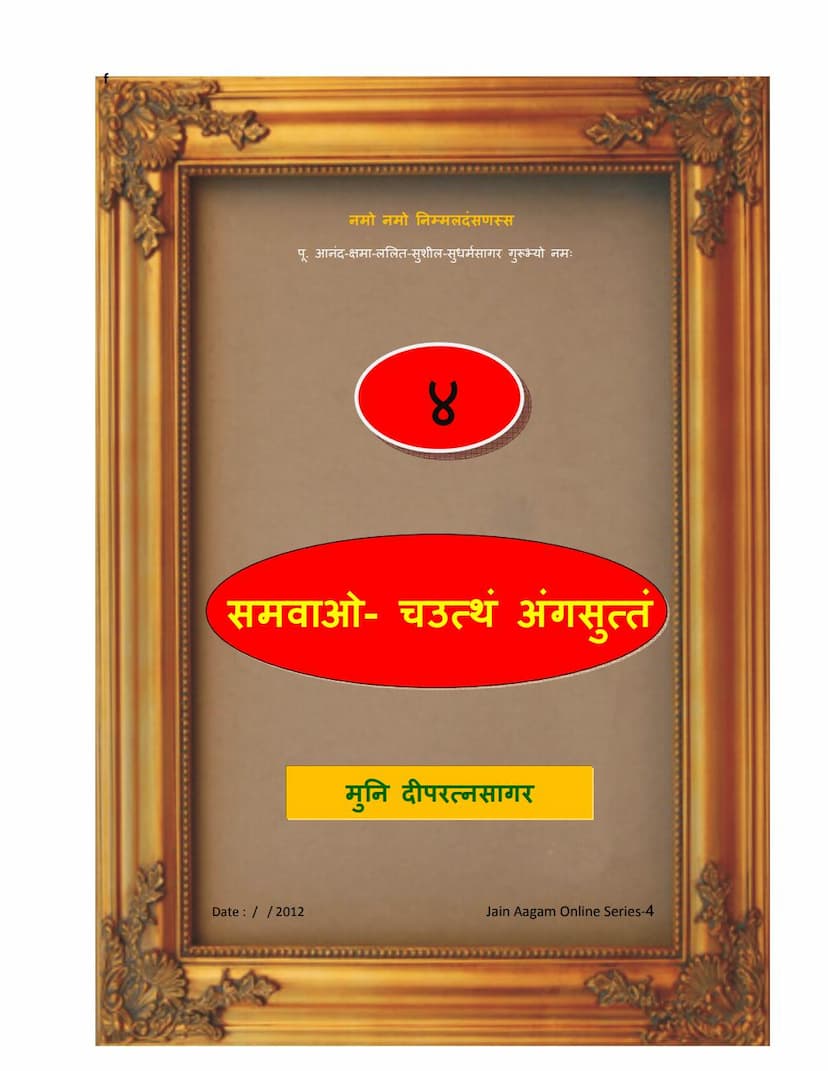Agam 04 Samvao Chauttham Angsuttam Mulam PDF File
Added to library: September 1, 2025

Summary
This document is a Jain text titled Agam 04 Samvao Chauttham Angsuttam Mulam PDF File, authored by Dipratnasagar and Deepratnasagar, and published by Deepratnasagar. It is part of the "Jain Aagam Online Series-4" and is for private and personal use only. The text is in Prakrit and is a commentary or elaboration of the Samavayo Sutra, the fourth Anga (part) of the Jain Agamas.
Here's a comprehensive summary based on the provided pages:
Overall Purpose and Structure:
The Samavayo Sutra, as presented here, is a foundational Jain scripture that aims to classify and enumerate various aspects of the Jain cosmology, philosophy, and practices. It follows a systematic approach, often cataloging items based on numerical order, from one to a very large number. The text is structured into numbered chapters (Samavayo 1, Samavayo 2, etc.), each focusing on a specific numerical category and listing various elements associated with it.
Key Content and Themes:
The document begins with invocations to the Tirthankaras and the purity of right perception (Nirmal Darshan). It then meticulously details numerous lists and classifications, primarily focusing on:
-
Cosmological and Geographical Details:
- Dimensions of various cosmic realms, continents (like Jambudvipa), and celestial abodes (Vimanas).
- Descriptions of different types of beings residing in these realms, including hell beings (Narakas), demi-gods (Asura Kumaras), and celestial beings (Devas).
- Information about life spans (Ayushkarma) and durations of existence in different celestial and infernal realms, often expressed in Palya and Sagaropama (units of time).
- Details about mountains, rivers, and the structure of the universe.
-
Classification of Beings and Phenomena:
- Categorization of beings based on their number of senses (e.g., one-sensed, two-sensed, etc.) and their types of existence (e.g., born from wombs, eggs, etc.).
- Lists of celestial bodies like constellations (Nakshatras), stars, and their classifications.
- Details about the karmic substances (karmas) and their classifications.
- The text enumerates various classifications based on numbers, starting from "one" (e.g., one dharma, one adharma, one pudgala).
-
Jain Principles and Practices:
- The text likely touches upon fundamental Jain principles such as the nature of soul (Jiva) and non-soul (Ajiva), bondage (Bandha) and liberation (Moksha), influx (Asrava) and stoppage of influx (Samvara), pain (Vedana) and expulsion of karma (Nirjara).
- It lists various types of vows, restraints (Samitis), vows of abstinence (Mahavratas), and disciplinary rules for monks and nuns.
- The text includes lists of virtues, vices, faults, and aspects of spiritual practice.
-
Specific Numerical Classifications (Examples based on page numbers):
- Page 4: Lists dualities like "one Jiva, one Ajiva," "one dharma, one adharma," "one punya, one papa." It starts detailing life spans of various beings in different realms, often in Palya and Sagaropama.
- Page 5: Continues detailing life spans, moving from one Palya/Sagaropama to two Palya/Sagaropama.
- Page 6: Focuses on classifications of three (e.g., three types of misconduct - Maya, Nidana, Mithyadarshan), and then four (e.g., four types of passions - Krodha, Mana, Maya, Lobha).
- Page 7: Lists five (e.g., five Mahavratas, five Samitis) and then six (e.g., six types of Jiva-nikayas).
- Page 8: Lists seven (e.g., seven types of fear-grounds) and then eight (e.g., eight types of pride).
- Page 9: Lists nine (e.g., nine types of celibacy practices) and then ten (e.g., ten types of monastic conduct).
- This pattern continues throughout the document, with subsequent chapters detailing eleven, twelve, thirteen, and so on, up to very high numbers, listing corresponding entities or concepts.
Authorship and Editing:
The text explicitly mentions that it has been "modified and edited by Muni Deepratnasagar" (मुनि दीपरत्नसागरेण संशोधितः सम्पादित्तश्च). This indicates that the presented version is a revised and scholarly edition of the original Samavayo Sutra.
Key Jain Concepts Highlighted:
The Samavayo Sutra, as this document demonstrates, is a treasure trove of specific details crucial for understanding the Jain worldview. It emphasizes:
- The importance of numerical classification: This method helps to categorize and understand the vastness and intricacies of the Jain universe and spiritual path.
- Detailed cosmological framework: The text provides precise (within the context of Jain cosmology) figures for durations, distances, and quantities.
- Enumeration of ethical and spiritual aspects: The lists of virtues, faults, and practices are essential for moral and spiritual development.
In essence, the Samavayo Sutra is an encyclopedic Jain text that systematically enumerates and classifies a wide range of phenomena, from the smallest temporal units to the vastest cosmic structures and the most minute spiritual practices, all organized by numerical progression. It serves as a reference text for understanding the comprehensive scope of Jain teachings.